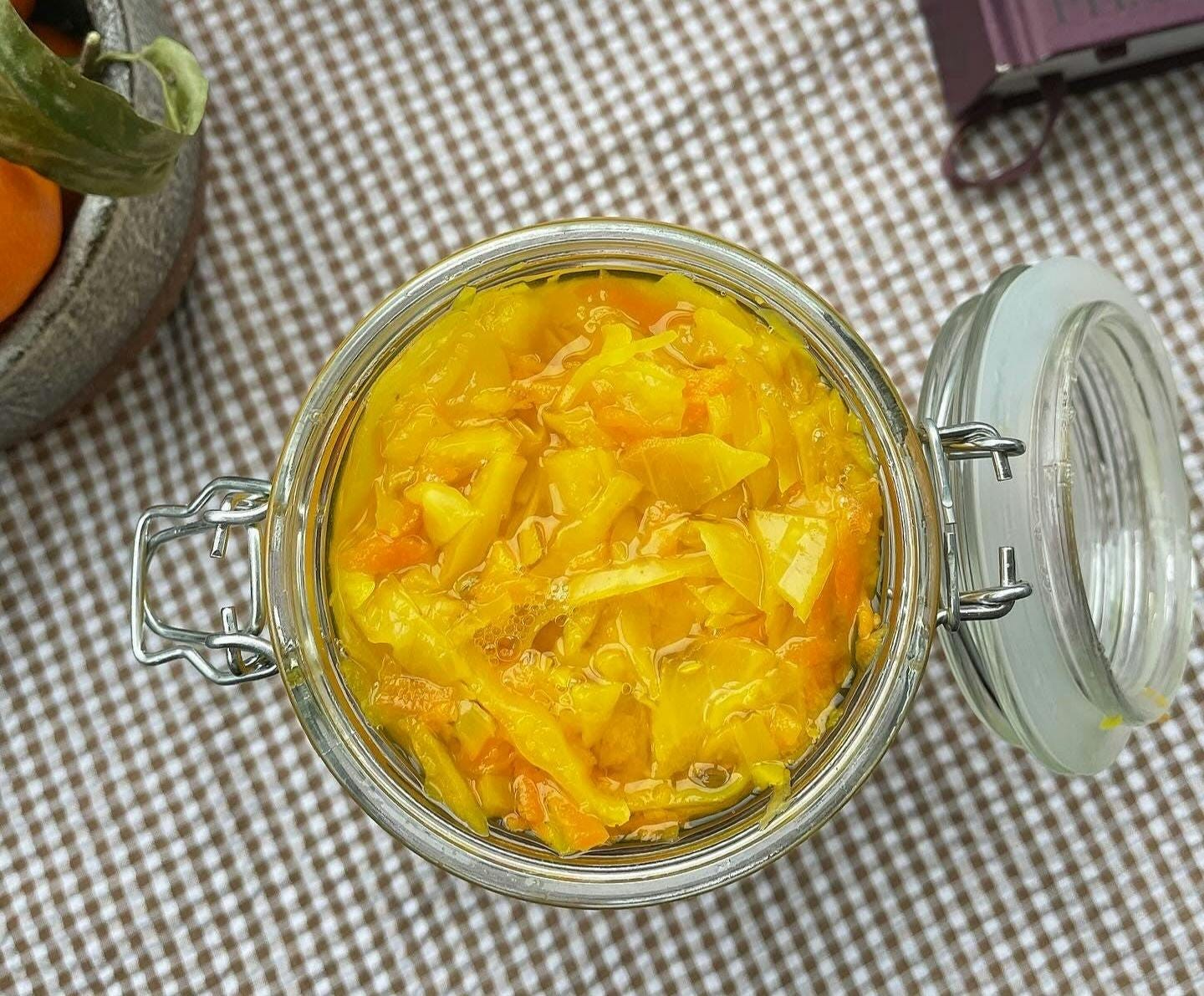Presenting Golden Kraut - a turmeric-infused sauerkraut loaded with garlic, ginger, and other delicious flavorings.
It’s mid-February and we could certainly do with a mid-winter boost - and this is it. Besides being loaded with probiotics, prebiotics, and loads of fiber, fermented vegetables are usually high in Vitamin C (which gets preserved through the fermentation process) alongside others.
ON TOP of all the goodness, ingredients like garlic and ginger are anti-microbial, and turmeric contains the compound curcumin which is anti-inflammatory ... add them into the mix, and you're getting a pretty delicious sauerkraut that's excellent for supporting your immune system. And if that doesn't convince you, that gorgeously bright marigold color definitely should.
Fermenting in the cold weather is usually a lengthy process.
Bacteria and yeasts are super active in warm weather, whilst taking their time in cooler temperatures. That’s why I was immensely surprised when a few days in, my kraut was all of a sudden overflowing, bubbly, and thriving despite the low number on the thermostat.
So let's break down a couple of key fermentation principles, ACTIVITY and SUGAR content, to get to the bottom of it.
Fermentation is a LIVE process, meaning that microorganisms - in this case, lactic acid bacteria - take over (or, colonize) a medium. They live off of the food the medium provides, and by doing so preserve the medium both for themselves and for us to eat.
And where does that food come from? The sugars present in the medium! Carbohydrates, in simple and complex forms - all those fibers you get in fruits and veggies - are all composed of sugars and provide EXCELLENT food for our lactic acid bacteria.
Circle back to our activity level. The bubbles you get in a ferment (whether that's the fizz in a fermented drink, or the bubbles in a sourdough starter), are evidence that your bacteria are alive and healthy. They are processing those sugars and turning them into carbon dioxide gas.
Yay! This means your ferment is full of probiotics (aka, live bacteria).
So why was mine so active in the dead of winter?
There could have been a few factors at play:
Sugar content of the ingredients was particularly high. Not in my control!
I had several ferments on the go and kept them next to each other. There's some fun cross-contamination that occurs where ferments will essentially boost each other by transferring bacteria cultures to their neighbors. Totally in my control!
I packed a bit too much kraut into my jar, leading to an inevitable overflowing, making it SEEM extra active. Totally in my control!
Remember! Because fermentation is a live process, the bacteria will do what they want, despite your best efforts to control them! What's important is to know the difference between what you can control and what you can't - and when you can't control something, to know how you can best steer the ferment in the direction you want.
Golden Kraut
For 1 lt jar
Ingredients:
1 small head of white cabbage (700-800g)
14-16g fine sea salt, or 2% of the total weight (2 tsp)
1 whole apple
1 medium carrot
2 garlic cloves, peeled
1 tbsp fresh grated ginger
2 tsp fresh grated turmeric (or 1tsp turmeric powder)
1 tsp coriander seeds
1 tsp fenugreek seeds
1 tsp cardamom seeds
Instructions:
Remove the brown end of the core, the outer leaf, and quarter the cabbage.
Shred the cabbage very finely, either by hand or using a mandolin.
In a large bowl, combine the shredded cabbage and salt.
Massage the cabbage with the salt to draw out the liquid, until it becomes limp and there’s a puddle at the bottom of the bowl.
Grate in the apple, the carrot, the cloves of garlic, and add the ginger, turmeric, and seeds. Mix well.
Grab a handful of the cabbage mix and place in the jar; using your fist or a blunt-tipped object (like a rolling pin), compress the layer down to get rid of air pockets and to make the liquid rise to the surface.
Continue packing all the cabbage in, bit by bit, until it’s well-compressed (leaving two inches from the mouth of the jar).
Wipe down the sides of the jar, both inside and outside, to remove any bits (which can get contaminated if exposed to oxygen for too long).
Add the remaining liquid to cover the surface of the mix.
Cover with a tea towel secured with a rubberband and let ferment at room temperature for 7-14 days. Push the veg down every day to re-submerge it (or use a fermentation weight).
Taste every day, and when it’s to your liking, seal the lid and refrigerate. Label your jar with the date and contents.





